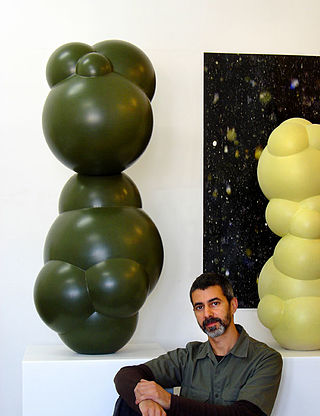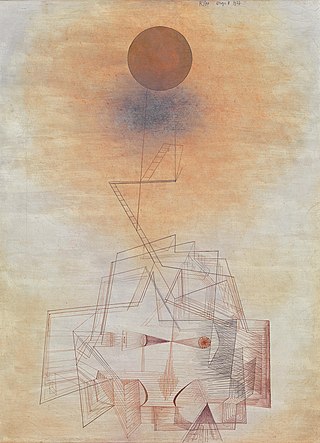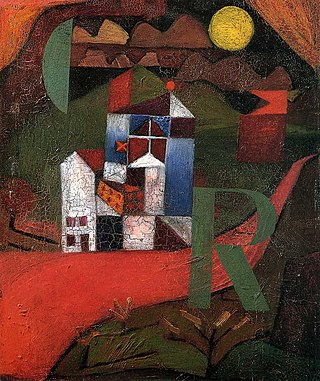
Systemic scleroderma, or systemic sclerosis, is an autoimmune rheumatic disease characterised by excessive production and accumulation of collagen, called fibrosis, in the skin and internal organs and by injuries to small arteries. There are two major subgroups of systemic sclerosis based on the extent of skin involvement: limited and diffuse. The limited form affects areas below, but not above, the elbows and knees with or without involvement of the face. The diffuse form also affects the skin above the elbows and knees and can also spread to the torso. Visceral organs, including the kidneys, heart, lungs, and gastrointestinal tract can also be affected by the fibrotic process. Prognosis is determined by the form of the disease and the extent of visceral involvement. Patients with limited systemic sclerosis have a better prognosis than those with the diffuse form. Death is most often caused by lung, heart, and kidney involvement. The risk of cancer is increased slightly.

Paul Klee was a Swiss-born German artist. His highly individual style was influenced by movements in art that included expressionism, cubism, and surrealism. Klee was a natural draftsman who experimented with and eventually deeply explored color theory, writing about it extensively; his lectures Writings on Form and Design Theory, published in English as the Paul Klee Notebooks, are held to be as important for modern art as Leonardo da Vinci's A Treatise on Painting was for the Renaissance. He and his colleague, Russian painter Wassily Kandinsky, both taught at the Bauhaus school of art, design and architecture in Germany. His works reflect his dry humor and his sometimes childlike perspective, his personal moods and beliefs, and his musicality.

Ben Shahn was an American artist. He is best known for his works of social realism, his left-wing political views, and his series of lectures published as The Shape of Content.

Morphea is a form of scleroderma that mainly involves isolated patches of hardened skin on the face, hands, and feet, or anywhere else on the body, usually with no internal organ involvement. However, in Deep Morphea inflammation and sclerosis can be found in the deep dermis, panniculus, fascia, superficial muscle and bone.

The Klimt University of Vienna Ceiling Paintings, also known as the Faculty Paintings, were a series of paintings made by Gustav Klimt for the ceiling of the University of Vienna's Great Hall between the years of 1900–1907. In 1894, Klimt was commissioned to paint the ceiling. Upon presenting his paintings, Philosophy, Medicine and Jurisprudence, Klimt came under attack for 'pornography' and 'perverted excess' in the paintings. None of the paintings would go on display in the university.

Painting is a visual art, which is characterized by the practice of applying paint, pigment, color or other medium to a solid surface. The medium is commonly applied to the base with a brush, but other implements, such as knives, sponges, and airbrushes, may be used. One who produces paintings is called a painter.

Scleroderma is a group of autoimmune diseases that may result in changes to the skin, blood vessels, muscles, and internal organs. The disease can be either localized to the skin or involve other organs, as well. Symptoms may include areas of thickened skin, stiffness, feeling tired, and poor blood flow to the fingers or toes with cold exposure. One form of the condition, known as CREST syndrome, classically results in calcium deposits, Raynaud's syndrome, esophageal problems, thickening of the skin of the fingers and toes, and areas of small, dilated blood vessels.
Pedagogical Sketchbook is a book by Paul Klee. It is based on his extensive lectures on visual form at Bauhaus Staatliche Art School where he was a teacher in between 1921-1931. Originally handwritten – as a pile of working notes he used in his lectures – it was eventually edited by Walter Gropius, designed by László Moholy-Nagy and published in as a Bauhaus student manual under the original title: Pädagogisches Skizzenbuch. It was translated into English by Sibyl Moholy-Nagy, who also wrote an introduction for it.

Paul Klee Notebooks is a two-volume work by the Swiss-born artist Paul Klee that collects his lectures at the Bauhaus schools in 1920s Germany and his other main essays on modern art. These works are considered so important for understanding modern art that they are compared to the importance that Leonardo's A Treatise on Painting had for Renaissance. Herbert Read called the collection "the most complete presentation of the principles of design ever made by a modern artist – it constitutes the Principia Aesthetica of a new era of art, in which Klee occupies a position comparable to Newton's in the realm of physics."

Ab ovo is a 1917 painting by Paul Klee (1879–1940) made during his time in the German Army. It is noteworthy for its sophisticated technique. It employs watercolor on gauze and paper with a chalk ground, which produces a rich texture of triangular, circular, and crescent patterns.

Fate of the Animals is a painting by Franz Marc created in 1913. It is oil on canvas. This work contrasts most of Marc's other works by presenting animals in a brutal way rather than depicting them in a peaceful manner. Marc's strong ties with animals as his subjects remains uncertain, but it is predicted to stem from his childhood dog. Fate of the Animals remains one of Marc's most famous pieces and displays Der Blaue Reiter style that he co-founded with Wassily Kandinsky. The painting currently resides in the Kunstmuseum in Basel, Switzerland.

David Fried is an American interdisciplinary, contemporary artist.

Limits of Reason is a 1927 painting by Paul Klee (1879-1940). It is in the permanent collection of the Pinakothek der Moderne—Pinakothek of modern art—in central Munich's Kunstareal.

Ad Parnassum is a pointillist painting by Swiss-born artist Paul Klee. The painting is currently in the Kunstmuseum Bern.

Villa R is an oil-on-carton painting from 1919 by the Swiss-born German artist Paul Klee.

Insula dulcamara is an oil painting on newsprint pasted to burlap by the Swiss-based abstract artist Paul Klee, initiated in 1938 when he was suffering from the wasting disease scleroderma. It is his largest work and part of the collection of the Zentrum Paul Klee in Bern.

The Donkey Rider is a watercolor created in 1914 by the German Expressionist painter August Macke. It was created during the art-historically significant trip to Tunisia that he took with fellow painters Paul Klee and Louis Moilliet in April 1914. The watercolor is now in the collection of the August-Macke-Haus in Bonn.

Angel, Still Groping is a watercolor on paper painting by Swiss German painter Paul Klee, from 1939. it is held at the Zentrum Paul Klee, in Bern.

Heroic Roses, known in German as Heroische Rosen, is an oil on stained canvas expressionist painting by Swiss-German painter Paul Klee, from 1938. It is held in the Kunstsammlung Nordrhein-Westfalen, in Düsseldorf.

















